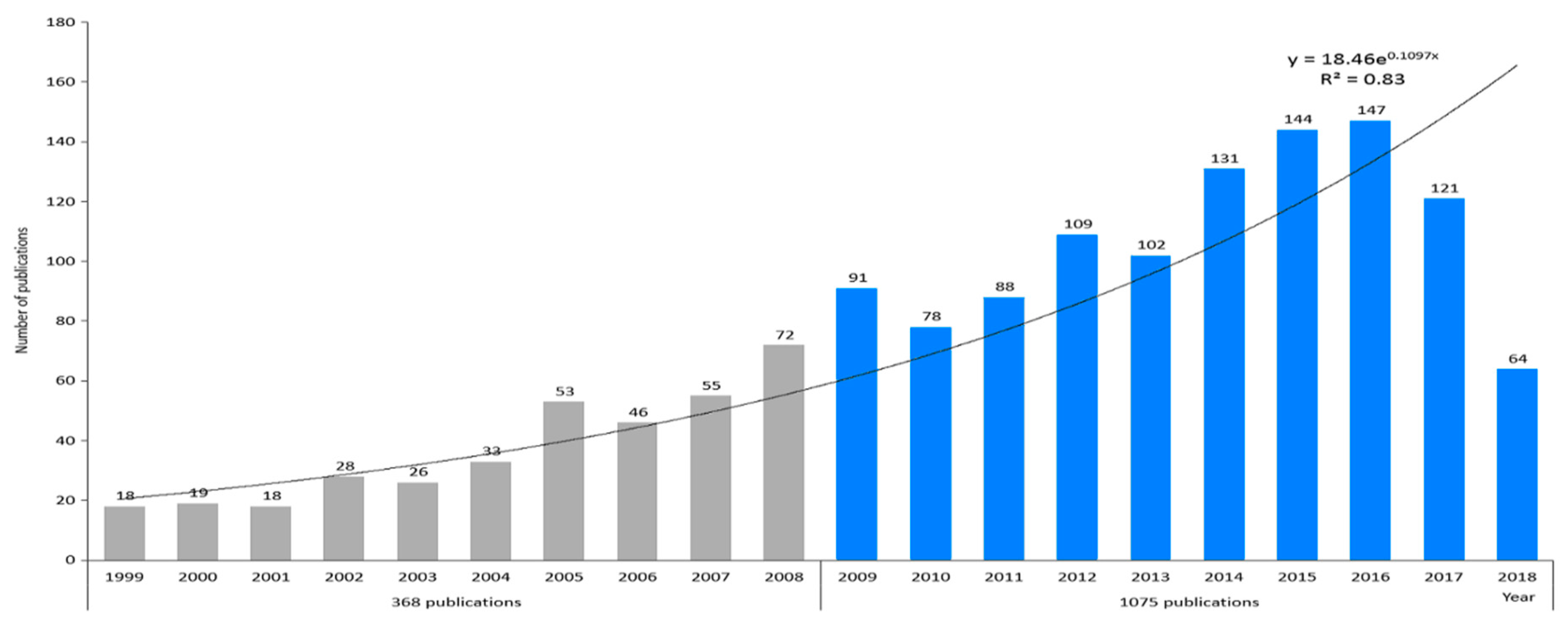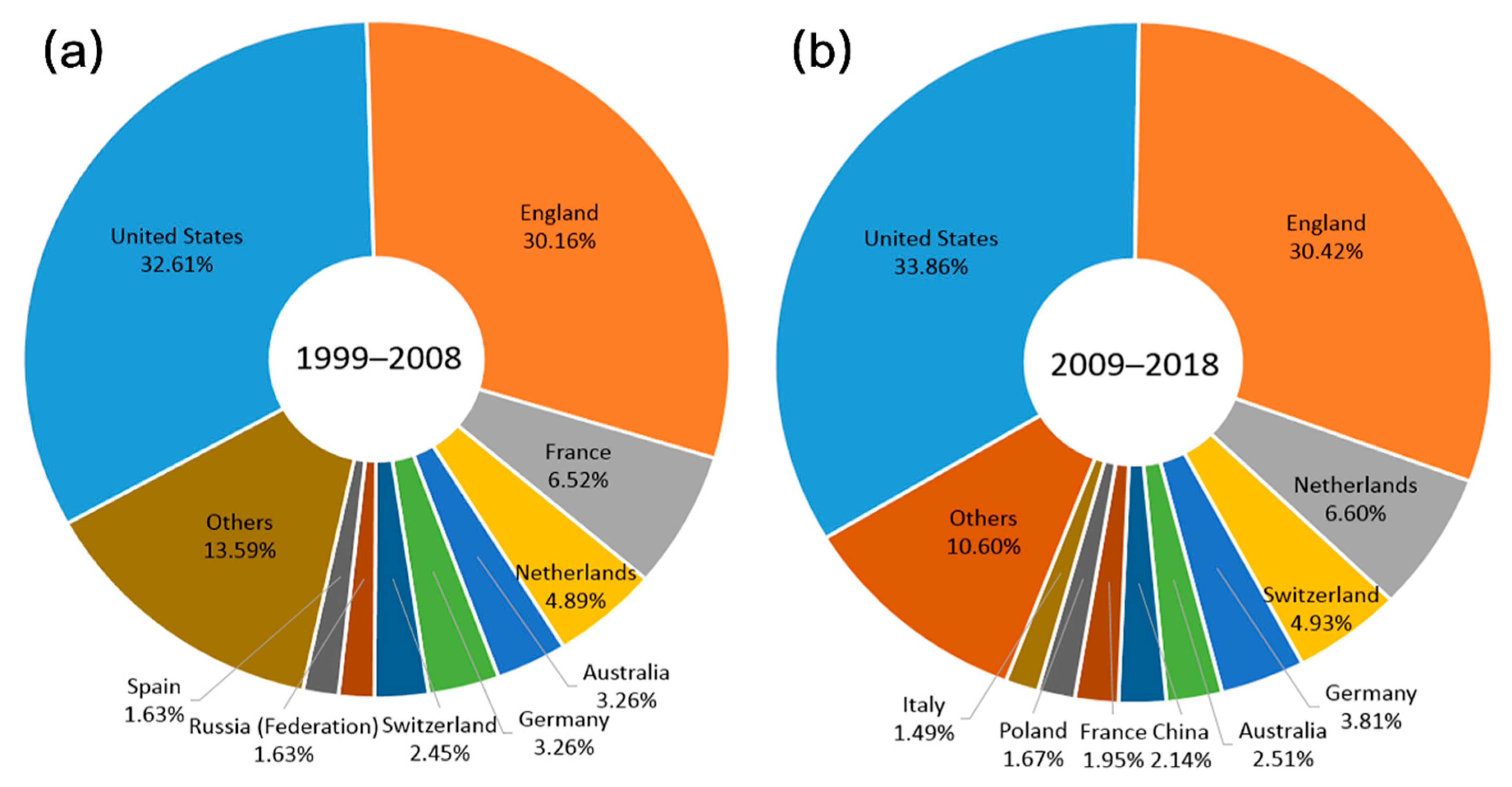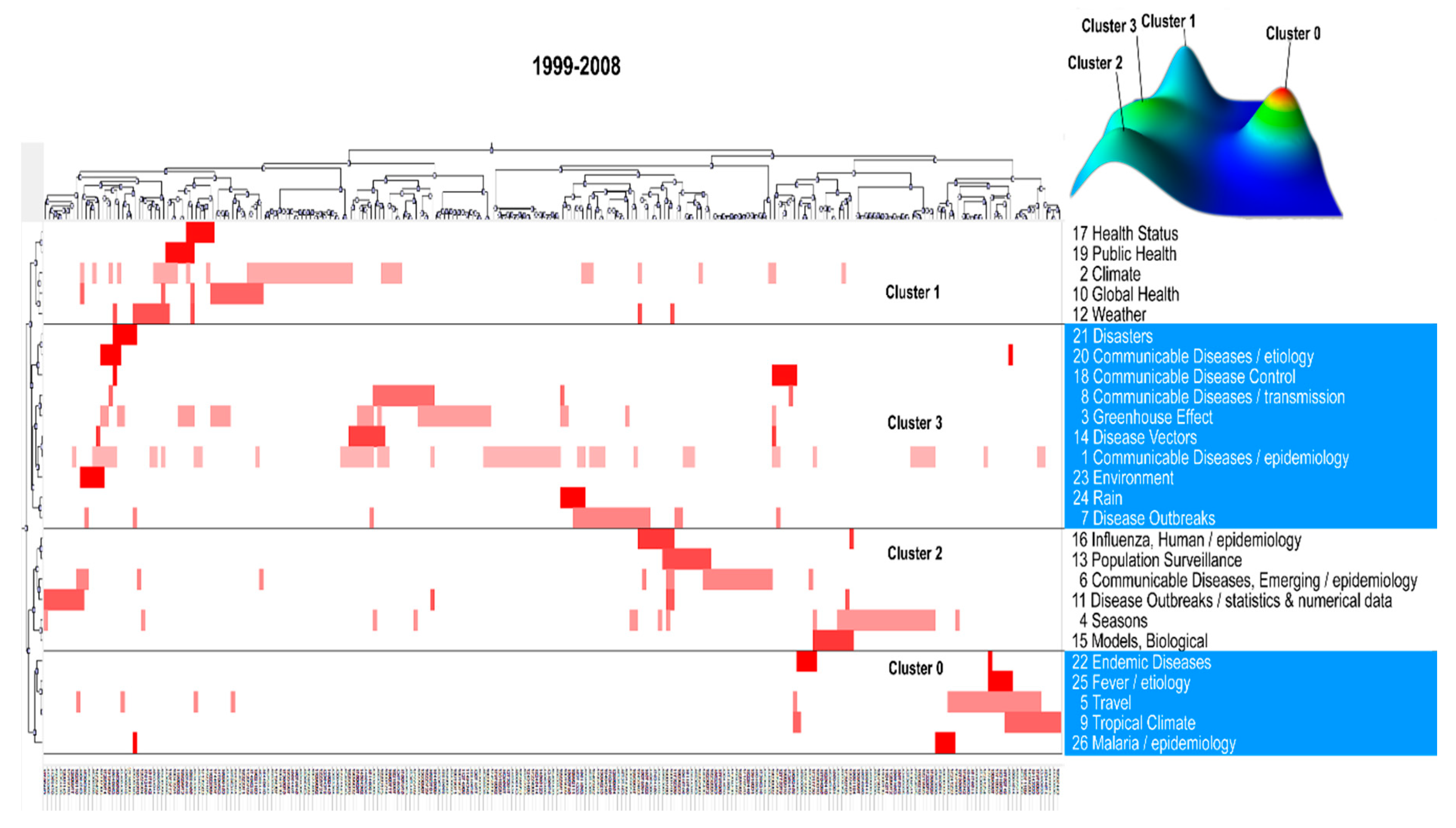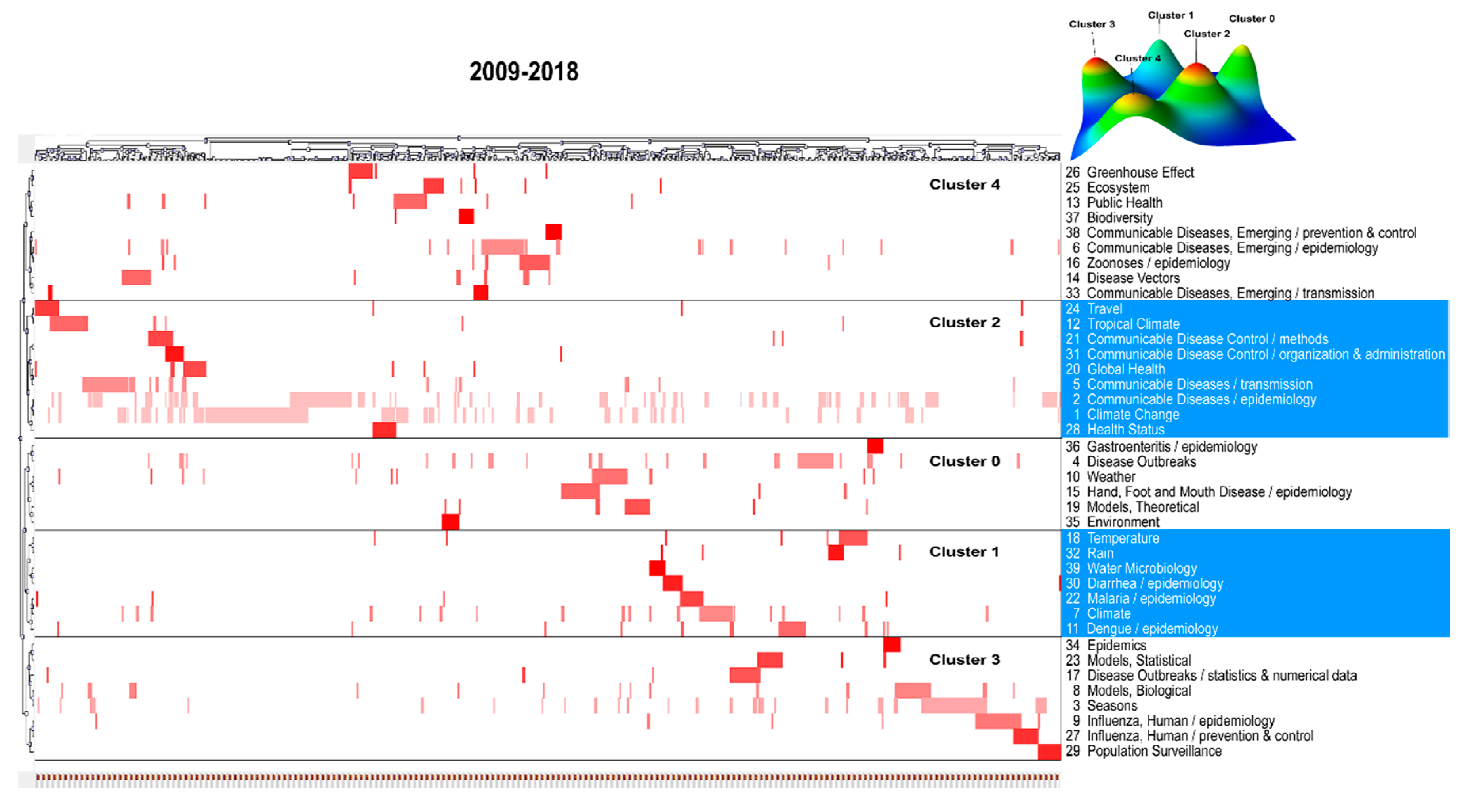Global Research Output and Theme Trends on Climate Change and Infectious Diseases: A Restrospective Bibliometric and Co-Word Biclustering Investigation of Papers Indexed in PubMed (1999–2018)
Abstract
1. Introduction
2. Materials and Methods
2.1. Data Collection
2.2. Data Analysis
3. Results
3.1. Growth and Journals of the Relevant Publications
3.2. Highly-Frequent MeSH/Subheading Combination Terms and Their Cluster Pattern
3.3. Trends of Research Themes
4. Discussion
4.1. Principal Findings
4.2. Limitations and Future Work
5. Conclusions
Supplementary Materials
Author Contributions
Funding
Conflicts of Interest
References
- McMichael, C. Human mobility, climate change, and health: Unpacking the connections. Lancet Planet Health 2020, 4, e217–e218. [Google Scholar] [CrossRef]
- Gartin, M.; Larson, K.L.; Brewis, A.; Stotts, R.; Wutich, A.; White, D.; du Bray, M. Climate change as an involuntary exposure: A comparative risk perception study from six countries across the global development gradient. Int. J. Environ. Res. Public Health 2020, 17, 1894. [Google Scholar] [CrossRef]
- Wu, X.; Lu, Y.; Zhou, S.; Chen, L.; Xu, B. Impact of climate change on human infectious diseases: Empirical evidence and human adaptation. Environ. Int. 2016, 86, 14–23. [Google Scholar] [CrossRef]
- Filho, W.L.; Scheday, S.; Boenecke, J.; Gogoi, A.; Maharaj, A.; Korovou, S. Climate change, health and mosquito-borne diseases:Trends and implications to the pacific region. Int. J. Environ. Res. Public Health 2019, 16, 5114. [Google Scholar] [CrossRef] [PubMed]
- Liu, J.; Wu, X.; Li, C.; Xu, B.; Hu, L.; Chen, J.; Dai, S. Identification of weather variables sensitive to dysentery in disease-affected county of China. Sci. Total Environ. 2017, 575, 956–962. [Google Scholar] [CrossRef]
- Smith, J.; Taylor, E.M. What is next for NTDs in the era of the sustainable development goals? PLoS Negl. Trop. Dis. 2016, 10, e0004719. [Google Scholar] [CrossRef] [PubMed]
- Helm, D. Climate policy: The Kyoto approach has failed. Nature 2012, 491, 663–665. [Google Scholar] [CrossRef] [PubMed]
- Rogelj, J.; McCollum, D.L.; Reisinger, A.; Meinshausen, M.; Riahi, K. Probabilistic cost estimates for climate change mitigation. Nature 2013, 493, 79–83. [Google Scholar] [CrossRef]
- Altizer, S.; Ostfeld, R.S.; Johnson, P.T.; Kutz, S.; Harvell, C.D. Climate change and infectious diseases: From evidence to a predictive framework. Science 2013, 341, 514–519. [Google Scholar] [CrossRef]
- McMichael, A.J.; Woodruff, R.E.; Hales, S. Climate change and human health: Present and future risks. Lancet 2006, 367, 859–869. [Google Scholar] [CrossRef]
- Dora, C.; Haines, A.; Balbus, J.; Fletcher, E.; Adair-Rohani, H.; Alabaster, G.; Hossain, R.; de Onis, M.; Branca, F.; Neira, M. Indicators linking health and sustainability in the post-2015 development agenda. Lancet 2015, 385, 380–391. [Google Scholar] [CrossRef]
- Kilpatrick, A.M.; Randolph, S.E. Drivers, dynamics, and control of emerging vector-borne zoonotic diseases. Lancet 2012, 380, 1946–1955. [Google Scholar] [CrossRef]
- Axelsen, J.B.; Yaari, R.; Grenfell, B.T.; Stone, L. Multiannual forecasting of seasonal influenza dynamics reveals climatic and evolutionary drivers. Proc. Natl. Acad. Sci. USA. 2014, 111, 9538–9542. [Google Scholar] [CrossRef]
- Patz, J.A.; Frumkin, H.; Holloway, T.; Vimont, D.J.; Haines, A. Climate change: Challenges and opportunities for global health. J. Am. Med. Assoc. 2014, 312, 1565–1580. [Google Scholar] [CrossRef] [PubMed]
- Shuman, E.K. Global climate change and infectious diseases. N. Engl. J. Med. 2010, 362, 1061–1063. [Google Scholar] [CrossRef] [PubMed]
- Konrad, S.K.; Miller, S.N. A temperature-limited assessment of the risk of Rift Valley fever transmission and establishment in the continental United States of America. Geosp. Health 2012, 6, 161–170. [Google Scholar] [CrossRef] [PubMed][Green Version]
- Massad, E.; Coutinho, F.A.; Lopez, L.F.; Da, S.D. Modeling the impact of global warming on vector-borne infections. Phys. Life Rev. 2011, 8, 169–199. [Google Scholar] [CrossRef]
- Ramasamy, R.; Surendran, S.N. Possible impact of rising sea levels on vector-borne infectious diseases. BMC Infect Dis. 2011, 11, 18. [Google Scholar] [CrossRef]
- Hertig, E. Distribution of Anopheles vectors and potential malaria transmission stability in Europe and the Mediterranean area under future climate change. Parasites Vectors 2019, 12, 18. [Google Scholar] [CrossRef]
- Xiang, J.; Hansen, A.; Liu, Q.; Tong, M.X.; Liu, X.; Sun, Y.; Cameron, S.; Hanson-Easey, S.; Han, G.S.; Williams, C.; et al. Association between malaria incidence and meteorological factors: A multi-location study in China, 2005–2012. Epidemiol. Infect 2018, 146, 89–99. [Google Scholar] [CrossRef]
- Hongoh, V.; Gosselin, P.; Michel, P.; Ravel, A.; Waaub, J.P.; Campagna, C.; Samoura, K. Criteria for the prioritization of public health interventions for climate-sensitive vector-borne diseases in Quebec. PLoS ONE 2017, 12, e0190049. [Google Scholar] [CrossRef] [PubMed]
- Tong, M.X.; Hansen, A.; Hanson-Easey, S.; Cameron, S.; Xiang, J.; Liu, Q.; Liu, X.; Sun, Y.; Weinstein, P.; Han, G.S.; et al. Perceptions of malaria control and prevention in an era of climate change: A cross-sectional survey among CDC staff in China. Malar J. 2017, 16, 136. [Google Scholar] [CrossRef] [PubMed]
- Moore, S.; Shrestha, S.; Tomlinson, K.W.; Vuong, H. Predicting the effect of climate change on African trypanosomiasis: Integrating epidemiology with parasite and vector biology. J. R. Soc. Interface 2012, 9, 817–830. [Google Scholar] [CrossRef]
- Thai, K.T.; Anders, K.L. The role of climate variability and change in the transmission dynamics and geographic distribution of dengue. Exp. Biol. Med. (Maywood) 2011, 236, 944–954. [Google Scholar] [CrossRef] [PubMed]
- Bai, Y.L.; Huang, D.S.; Liu, J.; Li, D.Q.; Guan, P. Effect of meteorological factors on influenza-like illness from 2012 to 2015 in Huludao, a northeastern city in China. PeerJ 2019, 7, e6919. [Google Scholar] [CrossRef]
- Bai, X.H.; Peng, C.; Jiang, T.; Hu, Z.M.; Huang, D.S.; Guan, P. Distribution of geographical scale, data aggregation unit and period in the correlation analysis between temperature and incidence of HFRS in mainland China: A systematic review of 27 ecological studies. PLoS Negl. Trop. Dis. 2019, 13, e0007688. [Google Scholar] [CrossRef]
- Cheng, Q.; Jing, Q.; Spear, R.C.; Marshall, J.M.; Yang, Z.; Gong, P. Climate and the timing of imported cases as determinants of the dengue outbreak in Guangzhou, 2014: Evidence from a mathematical model. PLoS Negl. Trop. Dis. 2016, 10, e0004417. [Google Scholar] [CrossRef]
- Dicko, A.H.; Percoma, L.; Sow, A.; Adam, Y.; Mahama, C.; Sidibe, I.; Dayo, G.K.; Thevenon, S.; Fonta, W.; Sanfo, S.; et al. A spatio-temporal model of African animal trypanosomosis risk. PLoS Negl. Trop. Dis. 2015, 9, e0003921. [Google Scholar] [CrossRef] [PubMed]
- Githeko, A.K.; Lindsay, S.W.; Confalonieri, U.E.; Patz, J.A. Climate change and vector-borne diseases: A regional analysis. Bull. WHO 2000, 78, 1136–1147. [Google Scholar]
- Randolph, S.E. Tick-borne encephalitis virus, ticks and humans: Short-term and long-term dynamics. Curr. Opin. Infect Dis. 2008, 21, 462–467. [Google Scholar] [CrossRef]
- Mas-Tur, A.; Guijarro, M.; Carrilero, A. The influence of the circular economy: Exploring the knowledge base. Sustainability 2019, 11, 4367. [Google Scholar] [CrossRef]
- Chantre-Astaiza, A.; Fuentes-Moraleda, L.; Muñoz-Mazón, A.; Ramirez-Gonzalez, G. Science mapping of tourist mobility 1980–2019. technological advancements in the collection of the data for tourist traceability. Sustainability 2019, 11, 4738. [Google Scholar] [CrossRef]
- Cui, L.; Liu, W.; Yan, L.; Zhang, H.; Hou, Y.; Huang, Y.; Zhang, H. Development of a text mining system based on the co-occurrence of bibliographic items in literature databases. New Technol. Libr. Inf. Serv. 2008, 4, 70–75. [Google Scholar]
- Li, F.; Li, M.; Guan, P.; Ma, S.; Cui, L. Mapping publication trends and identifying hot spots of research on Internet health information seeking behavior: A quantitative and co-word biclustering analysis. J. Med. Internet Res. 2015, 17, e81. [Google Scholar] [CrossRef]
- Zhang, S.; Liu, C.; Chang, Y. Selection research of keywords in co-word clustered based on the g-index of word frequency—Taking educational technology master thesis as an example. Mod. Educ. Technol. 2013, 23, 53–57. [Google Scholar]
- Egghe, L. Theory and practise of the g-Index. Scientometrics 2006, 69, 131–152. [Google Scholar] [CrossRef]
- Yang, A.; Ma, X.; Zhang, F.; Xue, W. Application research of g-index in the topic words of co-word analysis. J. Intell. 2012, 74, 52–55. [Google Scholar]
- Rasmussen, M.; Karypis, G. gCLUTO: An Interactive Clustering, Visualization, and Analysis System. CSE/UMN Technical Report: TR# 04–021. 2004. Available online: http://glaros.dtc.umn.edu/gkhome/node/174 (accessed on 25 May 2004).
- Law, J.; Bauin, S.; Courtial, J.P.; Whittaker, J. Policy and the mapping of scientific change: A co-word analysis of research into environmental acidification. Scientometrics 1988, 14, 251–264. [Google Scholar] [CrossRef]
- Guo, D.; Chen, H.; Long, R.; Lu, H.; Long, Q. A co-word analysis of organizational constraints for maintaining sustainability. Sustainability 2017, 9, 1928. [Google Scholar] [CrossRef]
- Callon, M.; Courtial, J.P.; Laville, F. Co-word analysis as a tool for describing the network of interactions between basic and technological research: The case of polymer chemsitry. Scientometrics 1991, 22, 155–205. [Google Scholar] [CrossRef]
- Bauin, S.; Michelet, B.; Schweighoffer, M.G.; Vermeulin, P. Using bibliometrics in strategic analysis: “understanding chemical reactions” at the CNRS. Scientometrics 1991, 22, 113–137. [Google Scholar] [CrossRef]
- Xu, Q.; Gel, Y.R.; Ramirez, R.L.; Nezafati, K.; Zhang, Q.; Tsui, K.L. Forecasting influenza in Hong Kong with Google search queries and statistical model fusion. PLoS ONE 2017, 12, e0176690. [Google Scholar] [CrossRef] [PubMed]
- Zhao, D.; Wang, L.; Cheng, J.; Xu, J.; Xu, Z.; Xie, M.; Yang, H.; Li, K.; Wen, L.; Wang, X.; et al. Impact of weather factors on hand, foot and mouth disease, and its role in short-term incidence trend forecast in Huainan City, Anhui Province. Int. J. Biometeorol. 2017, 61, 453–461. [Google Scholar] [CrossRef] [PubMed]
- Wu, X.; Hu, S.; Kwaku, A.B.; Li, Q.; Luo, K.; Zhou, Y.; Tan, H. Spatio-temporal clustering analysis and its determinants of hand, foot and mouth disease in Hunan, China, 2009–2015. BMC Infect Dis. 2017, 17, 645. [Google Scholar] [CrossRef] [PubMed]





| Period | Rank | Most Active Journals | Languages | Publication Places | Number of Publications | Percentage (%) |
|---|---|---|---|---|---|---|
| 1999–2008 | 1 | Emerging Infectious Diseases | English | United States | 11 | 2.99 |
| 2 | Journal of Travel Medicine | English | England | 9 | 2.45 | |
| 3 | Annals of the New York Academy of Sciences | English | United States | 6 | 1.63 | |
| 4 | International Journal of Health Geographics | English | England | 6 | 1.63 | |
| 5 | Medecine Tropicale: Revue du Corps de Sante Colonial | French | France | 6 | 1.63 | |
| 6 | Proceedings of the National Academy of Sciences of the United States of America | English | United States | 5 | 1.36 | |
| 7 | Epidemiology and Infection | English | England | 5 | 1.36 | |
| 8 | Revue Scientifique et Technique (International Office of Epizootics) | English, French, Spanish | France | 5 | 1.36 | |
| 9 | Nature | English | England | 5 | 1.36 | |
| 10 | New South Wales Public Health Bulletin | English | Australia | 5 | 1.36 | |
| Total | 63 | 17.12 | ||||
| 2009–2018 | 1 | PLoS One | English | United States | 64 | 5.93 |
| 2 | International Journal of Environmental Research and Public Health | English | Switzerland | 31 | 2.87 | |
| 3 | Epidemiology and Infection | English | England | 25 | 2.32 | |
| 4 | BMC Infectious Diseases | English | England | 23 | 2.13 | |
| 5 | PLoS Neglected Tropical Diseases | English | United States | 23 | 2.13 | |
| 6 | Przeglad Epidemiologiczny | English, Polish | Poland | 18 | 1.67 | |
| 7 | Proceedings of the National Academy of Sciences of the United States of America | English | United States | 18 | 1.67 | |
| 8 | Communicable Diseases Intelligence Quarterly Report | English | United States | 17 | 1.58 | |
| 9 | Emerging Infectious Diseases | English | United States | 17 | 1.58 | |
| 10 | Global Health Action | English | United States | 16 | 1.48 | |
| Total | 252 | 23.35 |
| Period | Cluster | Term * No. | Cluster Analysis |
|---|---|---|---|
| 1999–2008 | 0 | 22, 25, 5, 9, 26 | 1. Fever, malaria, and endemic diseases; 2. Travel and tropical climate |
| 1 | 17, 19, 2, 10, 12 | 1. Global health 2. Public health | |
| 2 | 16, 13, 6, 11, 4, 15 | 1. Human influenza and emerging communicable diseases 2. Season 3. Biological models | |
| 3 | 21, 20, 18, 8, 3, 14, 1, 23, 24, 7 | 1. Etiology, transmission, and control of communicable diseases 2. Greenhouse effect, disasters, environment, and rain | |
| 2009–2018 | 0 | 36, 4, 10, 15, 19, 35 | 1. Gastroenteritis and hand, foot, and mouth disease 2. Disease outbreaks 3. Environment |
| 1 | 18, 32, 39, 30, 22, 7, 11 | 1. Temperature and rain 2. Diarrhea, malaria, and dengue | |
| 2 | 24, 12, 21, 31, 20, 5, 2, 1, 28 | 1. Travel and tropical climate 2. Epidemiology, transmission, and methods, organization, and administration of communicable diseases 3. Global health | |
| 3 | 34, 23, 17, 8, 3, 9, 27, 29 | 1.Human influenza and epidemics 2. Statistical and biological model 3. Season | |
| 4 | 26, 25, 13, 37, 38, 6, 16, 14, 33 | 1. Greenhouse effect 2. Ecosystem and biodiversity 3. Public health 4. Emerging communicable diseases and zoonoses |
© 2020 by the authors. Licensee MDPI, Basel, Switzerland. This article is an open access article distributed under the terms and conditions of the Creative Commons Attribution (CC BY) license (http://creativecommons.org/licenses/by/4.0/).
Share and Cite
Li, F.; Zhou, H.; Huang, D.-S.; Guan, P. Global Research Output and Theme Trends on Climate Change and Infectious Diseases: A Restrospective Bibliometric and Co-Word Biclustering Investigation of Papers Indexed in PubMed (1999–2018). Int. J. Environ. Res. Public Health 2020, 17, 5228. https://doi.org/10.3390/ijerph17145228
Li F, Zhou H, Huang D-S, Guan P. Global Research Output and Theme Trends on Climate Change and Infectious Diseases: A Restrospective Bibliometric and Co-Word Biclustering Investigation of Papers Indexed in PubMed (1999–2018). International Journal of Environmental Research and Public Health. 2020; 17(14):5228. https://doi.org/10.3390/ijerph17145228
Chicago/Turabian StyleLi, Fan, Hao Zhou, De-Sheng Huang, and Peng Guan. 2020. "Global Research Output and Theme Trends on Climate Change and Infectious Diseases: A Restrospective Bibliometric and Co-Word Biclustering Investigation of Papers Indexed in PubMed (1999–2018)" International Journal of Environmental Research and Public Health 17, no. 14: 5228. https://doi.org/10.3390/ijerph17145228
APA StyleLi, F., Zhou, H., Huang, D.-S., & Guan, P. (2020). Global Research Output and Theme Trends on Climate Change and Infectious Diseases: A Restrospective Bibliometric and Co-Word Biclustering Investigation of Papers Indexed in PubMed (1999–2018). International Journal of Environmental Research and Public Health, 17(14), 5228. https://doi.org/10.3390/ijerph17145228





